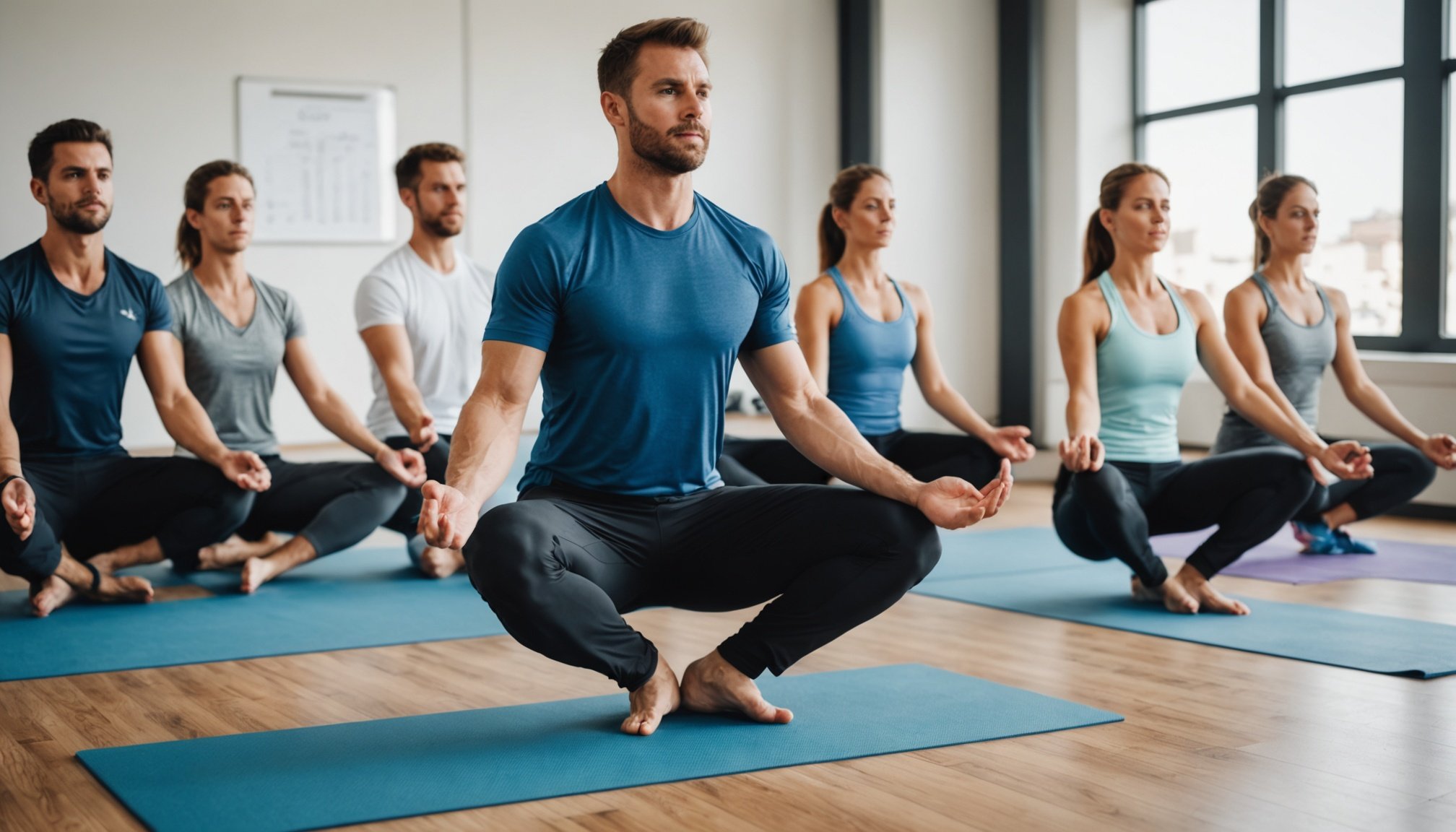Overview of Yoga and Its Role in Athletic Performance
Understanding the benefits of yoga for athletes begins with a grasp of the practice itself. Yoga is an ancient discipline originating from India, focusing on breath control, meditation, and adopting specific bodily postures for health and relaxation. Its core principles are balance, flexibility, and mindful awareness, making it a versatile tool in athletic training.
Historically, yoga’s integration into sports and athletic practices has steadily grown. Initially seen as a complementary exercise, it is now embraced as a cornerstone for enhancing athletic performance. For athletes, particularly in high-demand sports such as football, yoga offers physical and mental benefits that can significantly contribute to performance enhancement.
In the same genre : Conquering the spotlight: essential techniques for footballers to thrive in penalty kick situations
Yoga and football performance share common goals—enhancing strength, flexibility, and mental toughness. By incorporating yoga into routine training, athletes can improve their range of motion, reduce injury risk, and develop better concentration and focus on the field. The breathing exercises promote cardiovascular endurance, while meditation aspects aid in stress relief and mental clarity. Consequently, yoga is increasingly viewed not only as a physical regimen but as a holistic approach that prepares the mind and body to excel in athletic competitions.
Flexibility Benefits of Yoga for Football Players
In modern football, flexibility is a crucial component in preventing injuries and enhancing athletes’ performance. Yoga for flexibility facilitates a significant increased range of motion, which football players require to perform optimally on the field. By incorporating yoga into their training routine, players can improve their joint and muscle flexibility, providing them with stability and resilience against injuries.
In the same genre : Proven tactics for youth football coaches to navigate involved parents with confidence
Importance of Flexibility in Preventing Injuries
Flexibility is essential for football players as it helps reduce the risk of muscle strains and tears. Greater flexibility ensures that players can move freely and efficiently, reducing the likelihood of injuries during high-intensity play. Importantly, this flexibility allows athletes to recover faster from physical exertion, enhancing their overall game readiness.
Key Yoga Poses for Improving Lower Body Flexibility
Several yoga poses are particularly beneficial for enhancing lower body flexibility in football players. Poses such as the Pigeon Pose and Downward Dog are instrumental in improving hamstring and hip flexibility. Players who regularly practice these poses often notice significant improvements in their range of motion, allowing them to tackle and manoeuvre more effectively on the field.
Case Studies Showcasing Improved Flexibility in Athletes
Various case studies have highlighted how yoga has dramatically improved flexibility among athletes. Players who have committed to regular yoga sessions report not only fewer injuries but also enhanced agility and performance in games. These improvements in flexibility through yoga are clear evidence of its value to a football player’s training regimen.
Strength Development Through Yoga
Combining yoga for strength building with football training offers numerous advantages, as strength plays a pivotal role in football performance. Developing robust core stability and overall endurance correlates directly with improved agility, balance, and explosive power required on the field.
Incorporating specific yoga asanas into training routines can significantly enhance strength. For instance, Phalakasana (Plank Pose) intensifies core stability by engaging the abdominal muscles, while Virabhadrasana II (Warrior II Pose) targets leg strength and endurance through static holds. Moreover, Utkatasana (Chair Pose) fortifies the quadriceps and calves, simulating the power needed for sprints and jumps in football.
Football players have shared experiences where yoga has contributed to noticeable strength gains. One player highlighted how regularly practising yoga increased his core stability, which translated to superior performance when dribbling and holding his ground against opponents. Another player cited enhanced endurance and reduced injury rates due to the integration of yoga into his exercise regimen.
These testimonials underscore the practicality and benefits of harmonising yoga with traditional strength conditioning, affirming its role as a crucial component in a football player’s training toolkit. Embracing yoga aids in refining the physical capabilities necessary for peak performance on the pitch.
Mental Focus and Meditative Aspects of Yoga
To excel in sports, yoga for mental clarity is invaluable. It offers a natural way to enhance focus in sports, fostering a serene mental landscape that athletes need for peak performance. The practices of yoga, especially its breathing techniques, have a profound impact on concentration levels.
The connection between mental focus and athletic performance is evident in numerous studies. Athletes who integrate yoga into their training regimes often report significant improvements, not just in physical agility, but in mental acuity as well. This is because yoga equips them with tools to manage stress and maintain calmness, even in high-pressure situations.
Breathing techniques in yoga, such as Pranayama, serve as powerful methods to improve concentration. By regulating breath, athletes can control their emotional states, reducing anxiety and promoting a focused mind. This controlled breathing helps them remain present, fully engaged in the task at hand.
Research linking meditation and improved performance outcomes further supports the relevance of yoga in sports. Studies indicate that meditation leads to shorter reaction times, better decision-making skills, and enhanced endurance, all of which are crucial for athletic success. As athletes harness these benefits, they find themselves more centered, alert, and ready to tackle sporting challenges with clarity and precision.
Practical Yoga Routines for Football Training
Yoga routines for athletes, particularly for football players, can seamlessly aid in enhancing performance and preventing injuries. Tailoring specific yoga sequences to complement football training enables players to harness increased flexibility and body awareness. A sample routine might start with dynamic stretches, such as sun salutations, to warm up muscles and promote circulation. Following this, incorporate balance poses like Tree Pose, strengthening the legs and core. Finish with deep stretches, including Pigeon Pose, to release tension in the hips—a common area of tightness for athletes.
To maximize benefits, it is advisable to integrate yoga sessions 2-3 times a week, ideally after a football practice when muscles are warm and more pliable. Post-practice sessions also afford players a cooldown period, transitioning from high-intensity training to a more restorative state.
Incorporating yoga into existing programs involves adapting routines within team schedules. Practical integration includes considering yoga as an off-field training component; this can be supervised by a coach familiar with both athletics and yoga. When embedded into training regimens thoughtfully, yoga not only improves flexibility but also enhances focus and endurance, critical components to elevate athletic performance on the field.
Expert Insights and Testimonials
Yoga experts and high-performance athletes increasingly recognise the transformative power of yoga. Sports trainers frequently highlight yoga’s profound impact on athletes’ performance and well-being. Trainers often cite improved flexibility, enhanced focus, and decreased injury rates as significant benefits. These anecdotes are not mere hearsay, but evidence-based observations over years of working with top athletes.
Professional football players have their success stories intertwined with yoga’s practice. Many players attribute their career longevity and resilience to consistent yoga routines. For instance, athletes report that yoga aids in quicker injury recovery and stress reduction—elements crucial for maintaining peak performance.
Furthermore, expert opinions unanimously agree on yoga’s long-term benefits. Its regular practice is shown to support muscular balance and improve mental clarity, critical for sports excellence. By integrating yoga into training regimens, athletes gain a competitive edge through enhanced bodily awareness and mental fortitude.
Athlete testimonials serve as compelling evidence of these advantages, often citing experiences where yoga sessions led to personal records and improved game dynamics. It’s no surprise that, given such endorsements, yoga has become an essential component of contemporary athletic training programs. Whether through increased stability or sharpened focus, yoga undeniably plays a pivotal role in an athlete’s holistic development.
Scientific Studies Supporting Yoga in Sports
The potential benefits of yoga in sports research are increasingly garnering attention in scientific studies. Leading investigations have shed light on yoga’s positive impact on athletic performance, underscoring its growing importance in athletic training programs.
Relevant Studies Overview
Several scientific studies highlight yoga’s influence on various sports disciplines. For instance, a study on collegiate athletes revealed enhanced flexibility and balance in participants who incorporated yoga into their routines, showing improved performance metrics in competitive settings. Another research project focused on swimmers demonstrated increased lung capacity, attributed to regular yoga practice. These outcomes illustrate yoga’s ability to support overall athletic development.
Statistical Outcomes
Statistical evidence further reinforces yoga’s role in sports; athletes reported a significant decrease in injury incidence and recovery times after adopting yoga practices. In professional football, players showed a 20% improvement in agility tests and a 15% reduction in stress-related conditions. These quantifiable gains emphasize yoga’s potential for boosting athletic performance and well-being.
Gaps and Future Studies
However, gaps in scientific evidence around long-term effects remain. Many studies have yet to explore prolonged yoga involvement across diverse sports. Future research should target these areas, broadening the understanding of yoga’s extensive benefits and optimizing its integration into sports training. This pursuit will enrich knowledge and equip athletes with robust strategies for success.











